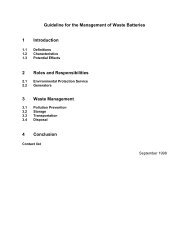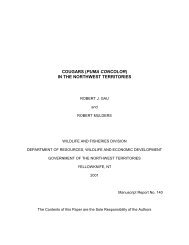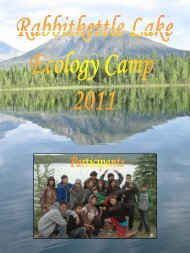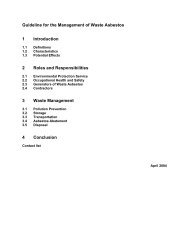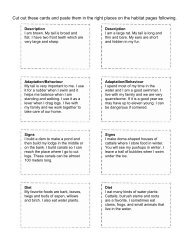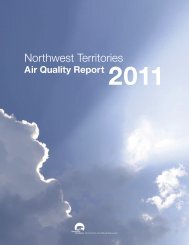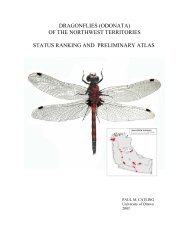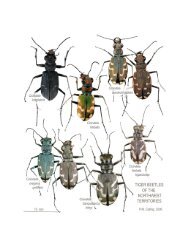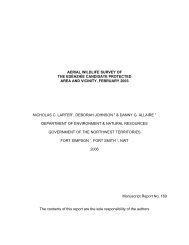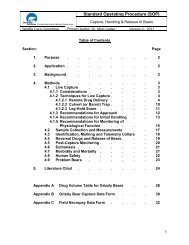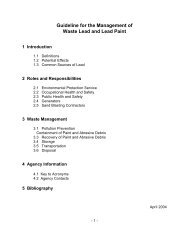Bats of the Northwest Territories
Bats of the Northwest Territories
Bats of the Northwest Territories
- No tags were found...
Create successful ePaper yourself
Turn your PDF publications into a flip-book with our unique Google optimized e-Paper software.
Their Unique Adaptations<strong>Bats</strong> are <strong>the</strong> only mammals capable <strong>of</strong> true flight.A thin membrane covers a set <strong>of</strong> fingers, whichtoge<strong>the</strong>r, act as wings.White-nose SyndromeWhite-nose syndrome is named for a distinctivewhite fungus on a bat’s muzzle and wings. Since2006, millions <strong>of</strong> hibernating bats have died <strong>of</strong>this disease in <strong>the</strong> eastern parts <strong>of</strong> Canada and<strong>the</strong> United States. White-nose syndrome has notbeen reported in <strong>the</strong> NWT but it may eventuallyspread north. It is not thought to be a humanhealth issue.White-nose syndrome is most commonly spreadfrom bat to bat but it can be spread from cave tocave on boots, equipment and clothing.<strong>Bats</strong> <strong>of</strong> <strong>the</strong><strong>Northwest</strong> <strong>Territories</strong><strong>Bats</strong> in <strong>the</strong> <strong>Northwest</strong><strong>Territories</strong>There are approximately 1200 species <strong>of</strong> batsworld-wide — more than one-fifth <strong>of</strong> <strong>the</strong> entireworld’s mammal species.In <strong>the</strong> NWT, only three species <strong>of</strong> bats wereknown before 2006. Thanks to research andpublic input, <strong>the</strong>re are now seven confirmedspecies and one suspected for a total <strong>of</strong> eight.Credit: Arizona State Parks<strong>Bats</strong> are nocturnal: <strong>the</strong>y sleep during <strong>the</strong> day andare active at night.You can help by staying out <strong>of</strong>caves that may contain bats.They are not blind but <strong>the</strong>y rely on <strong>the</strong>ir earsmore than <strong>the</strong>ir eyes to find food and navigate<strong>the</strong> night skies. Using echolocation (highfrequencysound waves bouncing <strong>of</strong>f objects),bats determine <strong>the</strong> shape, distance and size <strong>of</strong><strong>the</strong> objects around <strong>the</strong>m.Photo credit: Ryan von Linden/New York Department <strong>of</strong>Environmental ConservationIf you see a bat:Photo credit: J. M. Wilson/GNWTAll bats in <strong>the</strong> NWT eat insects. They canconsume <strong>the</strong>ir own body weight in insects eachnight. One little brown myotis can eat as manyas 600 mosquito-sized insects in one hour!In <strong>the</strong> summer, NWT bats roost (rest) in treehollows, under tree bark, among <strong>the</strong> leaves <strong>of</strong>trees, in caves, in rock crevices and in buildings.Credit: Outcrop Communications<strong>Bats</strong> are long-living and reproduce very slowly.Many bat species only produce one pup per year.This makes <strong>the</strong>m sensitive to population decline.• Do not handle it• Take a photo if you can• For advice on dealing with bats inbuildings, go to www.batcon.orgIn <strong>the</strong> winter, some NWT bat species migratesouth to warmer areas. O<strong>the</strong>r species stay andhibernate in caves or deep crevices.<strong>Bats</strong> are warm-blooded and can withstand a widerange <strong>of</strong> body temperatures. In <strong>the</strong> summer,<strong>the</strong>y rely on <strong>the</strong> sun to warm up <strong>the</strong>ir roosts andpromote rapid growth <strong>of</strong> young bats. On cold days,in both summer and winter, <strong>the</strong>ir body temperaturedrops as <strong>the</strong>y enter a state <strong>of</strong> torpor (deep sleepand low metabolic rate) to save energy.For more information, contact yourregional ENR <strong>of</strong>fice or call(867) 920-6327Help us monitor bats!Report all bat observations toWILDLIFEOBS@gov.nt.caPhoto credit: J. M. Wilson/GNWT
Little Brown MyotisMyotis lucifugusThe little brown myotis is <strong>the</strong> most common batin <strong>the</strong> NWT. It is known to hibernate here. Thisbat <strong>of</strong>ten lives in colonies in buildings but alsoroosts in trees and rock crevices.Wingspan: 22 to 27 cmWeight: 8 to 9 gramsLifespan: Up to 36 yearsRank: May be at riskin <strong>the</strong> NWTStatus:Endangered in CanadaNor<strong>the</strong>rn MyotisMyotis septentrionalisThe nor<strong>the</strong>rn myotis looks similar to a little brownmyotis but its ears are longer. This bat searches forits prey in more cluttered areas like forest edges andovergrown trails. Sometimes it catches insects sittingon twigs or leaves.Wingspan: 23 to 26 cmWeight: 7 to 8 gramsLifespan: About 20 yearsRank: May be at riskin <strong>the</strong> NWTStatus:Endangered in CanadaLong-eared MyotisMyotis evotisThe long-eared myotis is characterized by itsdistinctive long black ears. Its relatively quietecholocation calls are good for sneaking up onprey and moving through cluttered areas.Wingspan: 25 to 29 cmWeight: 7 gramsLifespan: Up to 22 yearsRank: May be at riskin <strong>the</strong> NWTLong-legged MyotisMyotis volansThe long-legged myotis looks very similar to alittle brown myotis and is typically dark brown.It is a bat that lives primarily in coniferousforests.Wingspan: 25 to 27 cmWeight: 8 gramsLifespan: Up to 21 yearsRank: May be at riskin <strong>the</strong> NWTPhoto credit: Michael Durham/BatConservation International (BCI)Photo credit: J. Scott AltenbachPhoto credit: J. Scott AltenbachPhoto credit: Michael Durham/BCIBig Brown BatEptesicus fuscusThe big brown bat is ahigh flier and is easy tospot early in <strong>the</strong> night.This species lives in avariety <strong>of</strong> habitats androosts in trees, rockcrevices and buildings.Wingspan: 32 to 39 cmWeight: 18 to 19 gramsLifespan: 20 yearsRank: Undetermined in<strong>the</strong> NWTSilver-haired BatLasionycteris noctivagansThe silver-haired bat has black wings and dark,silver-tipped hair. It is thought this speciesmigrates south for <strong>the</strong> winter.Wingspan: 27 to 31 cmWeight: 11 gramsLifespan: Up to 12 yearsRank: Undetermined in<strong>the</strong> NWTHoary BatLasiurus cinereusThe hoary bat, named for <strong>the</strong> frosted appearance<strong>of</strong> its fur, roosts among <strong>the</strong> leaves andneedles <strong>of</strong> trees. It is <strong>the</strong> largest bat in Canadaand migrates south for <strong>the</strong> winter.Wingspan: 34 to 41 cmWeight: 28 gramsLifespan: Up to 12 yearsRank: Undetermined in<strong>the</strong> NWTEastern Red BatLasiurus borealisThe eastern red bat’s distinctive orange to redcolouring stands out among o<strong>the</strong>r bats. Thisbat migrates south for <strong>the</strong> winter. Its uniqueultrasound has been recorded in <strong>the</strong> NWTbut <strong>the</strong>re have been nocaptures.Wingspan: 22 to 33 cmWeight: 13 gramsLifespan: About 12 yearsRank: Presence expectedin <strong>the</strong> NWTPhoto credit: Cori LausenPhoto credit: Michael Durham/BCI Photo credit: Michael Durham/BCI Photo credit: Merlin D. Tuttle/BCICover photo credits:Long-eared myotis - Michael Durham/BCILittle brown myotis - Merlin D. Tuttle/BCILittle brown myotis - Michael Durham/BCINote: Maps are based on confirmed observations and willchange as new information becomes available.



